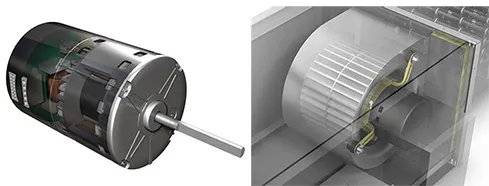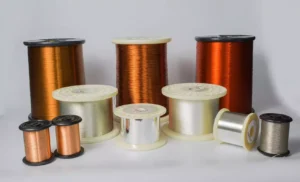Are your energy bills too high because of old, inefficient fan motors?
This constant waste of power costs you money every single day.
Modern Electronically Commutated (EC) motors offer a powerful, energy-saving solution.
An Electronically Commutated (EC) motor is a brushless DC motor with built-in electronics.
This design allows it to run on an AC power supply.
It combines the best features of both AC and DC motors, making it highly efficient and easy to control.
This might sound complex, but the idea is simple.
EC motors use smart technology to do the same job as older motors, but they use much less energy.
To really see why EC motors are the future, it helps to understand how they are built and how they compare to the motors you might have now.
Let’s look at the key differences that make EC motors a smarter choice.
Motor Design: Internal vs. External Rotor
Conventional motors can be bulky and take up a lot of space in machines.
This extra size can make installation difficult and limit design options.
An external rotor motor provides a much more compact and integrated solution.
Internal rotor motors have a traditional design where the rotating part (rotor) is located inside the fixed part (stator).
External rotor motors reverse this, with the rotor spinning on the outside of the stator, creating a more compact and integrated unit.
To understand why this matters, let’s look closer at each design.
The way a motor is built has a big impact on its size and how it fits into a larger assembly, like a fan.
The Conventional Internal Rotor Motor
The internal rotor motor is the style most people think of when they picture an electric motor.
The design is straightforward.
The stator is the stationary part of the motor and it is fixed to the motor’s housing.
The stator contains electrical windings that create a magnetic field when electricity passes through them.
Inside the stator is the rotor, which is the part that spins.
The rotor transmits its turning force, or torque, through a shaft that sticks out from the motor housing.
In an application like a fan, the fan impeller is attached to this rotating shaft.
The whole assembly works, but it requires separate parts: the motor, the shaft, and the impeller.
This adds to the overall size and complexity of the final product.
While this design has been used for a very long time, it is not always the most efficient use of space.
The Compact External Rotor Motor
The external rotor motor takes the conventional design and flips it inside out.
In this configuration, the rotor rotates on the outside of the stator.
This clever change has several important benefits.
The most significant advantage is that it eliminates the need for a separate output shaft.
Because the rotor itself is on the outside, a fan impeller can be attached directly to the rotor’s external surface.
This effectively combines the motor and the impeller into a single, compact unit called a motorized impeller.
This design greatly reduces the total footprint of the motor and fan assembly.
By making the motor smaller and integrating it directly with the fan blade, manufacturers can save a lot of space.
This is especially useful in modern equipment where space is limited.
The compact design not only saves space but also contributes to better airflow and efficiency.
AC vs. DC vs. EC: What’s the Difference?
Choosing the right motor can be confusing with all the different types available.
Making the wrong choice can lead to wasted energy and higher operating costs.
Understanding the basic differences between AC, DC, and EC motors makes it easy to see which one is the best fit.
AC induction motors use alternating current to generate a magnetic field, while DC motors use direct current and mechanical brushes to operate.
An EC motor is a brushless DC motor that uses smart on-board electronics to run on an AC power supply, making it far more efficient and controllable.
All electric motors do the same basic job: they turn electrical energy into mechanical motion.
But how they do it is very different.
These differences affect their performance, efficiency, and lifespan.
Let’s break down each type.
The AC Induction Motor
AC induction motors are very common.
They work by using the alternating current (AC) from a wall outlet.
This current flows through electrical windings in the stator, which is the stationary part of the motor.
This creates a rotating magnetic field.
This magnetic field then induces a current in the rotor, which is the rotating part.
The interaction between the two magnetic fields produces the torque that makes the rotor spin.
A key limitation of AC motors is their speed.
Their speed is tied to the frequency of the AC power supply, which is fixed.
Because of this, they are designed to run at a specific speed where they are most efficient.
If they operate outside of this narrow speed range, their efficiency drops significantly.
To change the speed, you need a separate device called a variable frequency drive (VFD).
A VFD can change the frequency of the AC supply, but these devices are often bulky and expensive.
For this reason, AC motors are best for applications that only need to run at one constant speed.
The DC Brushed Motor
DC motors work a little differently.
They use permanent magnets in the stator to create a fixed magnetic field.
The rotor has electrical windings that are energized by a direct current (DC) power supply.
To keep the motor spinning, the direction of the current in the rotor windings has to be switched continuously.
In a brushed DC motor, this is done mechanically using carbon brushes and a commutator ring.
The main advantage of DC motors is that their speed can be controlled much more easily than AC motors, simply by changing the supply voltage.
However, they have significant drawbacks.
The carbon brushes and commutator are mechanical parts that wear down over time.
This wear and tear can create more noise and leads to a shorter life for the motor.
Also, DC power is not as common as AC power, so using a DC motor often means you need a separate AC-to-DC rectifier, which adds cost and complexity.
The EC Permanent Magnet Motor
EC motors take the best features from both AC and DC motors and improve on them.
Like a DC motor, an EC motor uses permanent magnets in the rotor.
But, as its name suggests, it achieves commutation electronically instead of with mechanical brushes.
This is possible because it has smart electronics built right into the motor’s housing.
Here’s how it works: the on-board electronics first take the standard AC power supply and convert it to DC power using a rectifier.
Then, an integrated controller acts like a brain for the motor.
It uses Hall effect sensors to know the exact position of the magnets in the rotor at all times.
Based on this information, the controller directs the right amount of current, in the right direction, to the right windings in the stator at precisely the right time.
This creates magnetic poles in the stator that interact with the permanent magnets in the rotor.
By carefully controlling the attraction and repulsion forces, the motor produces optimal torque and smooth rotation.
Because this entire process is managed electronically, it allows for extremely precise motor control and monitoring.
Advantages of an Electronically Commutated (EC) Motor
Old motors are inefficient, noisy, and can lead to high energy and maintenance bills.
This constant drain on resources is a problem for any application.
EC motors provide a modern solution with major advantages in efficiency, control, and lifespan.
EC motors are extremely energy-efficient, often reaching over 90% efficiency.
They provide precise speed control without extra devices, run cooler and quieter, and have a longer service life because they have no brushes to wear out.
The benefits of EC technology are clear and impact everything from your energy bill to the comfort of the people in the building.
The integrated electronics are the key to these advantages, making EC motors a smarter choice for a wide range of uses.
Unmatched Energy Efficiency
The most significant advantage of an EC motor is its high efficiency.
EC motor efficiency is often above 90%, which allows fans using these motors to consume up to 70% less energy compared to fans with conventional motors.
This efficiency is not just at full speed.
Unlike AC motors that lose efficiency dramatically at lower speeds, EC motors maintain very high efficiency across a wide range of speeds.
For example, an EC motor can be turned down to 20% of its full speed and still maintain 85% efficiency.
The energy savings can be huge.
Running an EC fan at 80% speed can save nearly 50% of the energy compared to running it intermittently.
This high efficiency leads to other benefits.
Because less energy is wasted, EC motors produce less heat.
Lower operating temperatures reduce stress on the motor’s windings and bearings, which helps to extend the life of the motor.
In cooling applications, like air conditioning or refrigeration, this is a double win.
The fan itself adds less heat to the system, which reduces the overall cooling load and improves the system’s efficiency.
Finally, high efficiency also means less energy is lost as sound, making EC motors operate much more quietly.
Ease of Control and Versatility
The integrated electronics that make EC motors so efficient also make them incredibly easy to control.
The on-board controller continuously monitors the motor’s functions and adjusts the input to keep efficiency high at any speed.
This allows for simple and precise speed control.
Sensors that produce a standard control signal, such as 0-10 V, PWM, or 4-20 mA, can be connected directly to most EC motors.
This gives you variable speed control without needing a large, expensive, and complex variable frequency drive (VFD) like you would for an AC motor.
This built-in control also makes EC motors very versatile.
They are not limited by the synchronous speed rating that restricts AC motors.
EC motors are capable of running at speeds higher than their rated speed.
This allows a smaller EC fan to achieve the same performance as a much larger conventional fan, saving space.
The combination of a wide operating range and high efficiency at partial load means that a single EC fan model can often replace multiple types and sizes of older fans.
This simplifies inventory and makes it easier to match performance for any given application.
Key Benefits Summary
| Feature | AC Induction Motor | DC Brushed Motor | EC Motor |
| Efficiency | Lower, peaks at one speed | Moderate | Very High (Often >90%) across a wide speed range |
| Speed Control | Difficult, requires external VFD | Easy, change voltage | Very easy, integrated electronics |
| Lifespan | Long | Shorter due to brush wear | Very long, no brushes to wear out |
| Noise Level | Moderate to High | Can be noisy due to brushes | Very low, quiet operation |
| Operating Temp | Higher | Moderate | Lower, runs cool |
| Size | Can be bulky | Moderate | Compact, especially external rotor models |
EC Fan Applications
Finding the right fan for an HVAC or ventilation system can be a challenge.
Using a mismatched or inefficient fan wastes energy and may not provide the right amount of airflow.
EC fans are a versatile and effective solution for many common applications.
EC fans are excellent upgrades for ventilation systems, air handling units (AHUs), and various cooling applications like refrigeration.
Their high efficiency and superior control make them a great choice for both newly manufactured equipment and for retrofitting older systems to save energy.
The decision to use an EC fan often comes down to the payback period, which is the time it takes for the energy savings to cover the initial cost.
This payback is fastest when replacing very inefficient fans or fans that are used frequently.
Let’s explore some of the best opportunities for using this technology.
Ventilation Systems
Ventilation systems are one of the best places to use EC fans for two main reasons.
First, many ventilation fans use fractional horsepower motors that are often inexpensive but also very inefficient.
Replacing these with highly efficient EC motors offers a great opportunity for energy savings.
Second, many ventilation systems use fixed-speed fans that are simply turned on and off to control airflow.
This is not an efficient way to operate.
An EC fan can be run continuously at a reduced speed instead.
This provides a constant, gentle circulation of fresh air, which improves overall air quality, comfort, and health.
Even when running continuously at a lower speed, the EC fan can still lead to a decrease in utility bills because of its high efficiency at partial loads.
This approach also results in more even temperature distribution throughout a space.
Air Handling Units (AHUs) and HVAC
EC fans are a highly recommended upgrade for air handling units, which are a core part of many heating, ventilating, and air conditioning (HVAC) systems.
In the past, large AHUs used AC motors with belt drives to move the impeller.
These systems take up a lot of space and require regular maintenance because the belts wear out.
EC fans, especially those with an integrated motorized impeller, are much more compact and have no belts to replace, making them a great retrofit option.
The precise speed control of EC fans allows the airflow to be perfectly matched to the changing needs of the building.
Instead of running at full power all the time, the fan can adjust its speed based on demand, which saves a significant amount of energy.
In HVAC systems, this helps to reduce energy consumption, provide more stable temperatures, and reduce operating noise.
Cooling and Refrigeration
EC fans are especially appealing for cooling applications, such as in air conditioners or refrigeration condenser units.
The reason is simple: EC motors are so efficient that they dissipate very little energy in the form of heat.
Any heat added to a refrigerated space by a fan motor is an extra load that the cooling system has to work to remove.
By using an EC fan that runs much cooler than an AC motor, you reduce the load on the entire system.
This effect leads to higher system efficiency and lower energy bills.
For example, if you can keep the refrigerant pressure in a cooling system constant instead of having it rise and fall as fans turn on and off, it puts less pressure on the compressor, which saves energy.
The quieter operation of EC fans is also a major benefit in these applications, leading to increased comfort for anyone nearby.
Conclusion
In short, EC motors are a superior technology.
They combine the advantages of AC and DC motors into a compact, efficient, and versatile package that saves money and improves performance.
Frequently Asked Questions (FAQs)
What does EC stand for in a motor?
EC stands for Electronically Commutated.
This means the motor uses smart electronics, not mechanical brushes, to control the rotation, making it more efficient and reliable.
Are EC motors AC or DC?
They are technically brushless DC motors at their core, but they are designed to run on a standard AC power supply.
On-board electronics convert the AC power to DC to run the motor.
Do EC motors use brushes?
No, EC motors are brushless.
This eliminates the parts that wear out the fastest in many traditional motors, leading to a much longer service life and less maintenance.
Can you control the speed of an EC motor?
Yes, precise speed control is a major advantage of EC motors.
Their integrated electronics allow for easy and efficient speed adjustment across a wide range without needing extra equipment.
Are EC motors more expensive?
The initial purchase price of an EC motor can be higher than a traditional motor.
However, they quickly pay for themselves through significant energy savings and a longer lifespan.
Why are EC motors so efficient?
Their efficiency comes from their brushless DC motor design, the use of powerful permanent magnets, and the smart electronic controls that ensure the motor always runs at its optimal point.
What is the difference between an ECM and a PSC motor?
An ECM (Electronically Commutated Motor) is about 80% efficient, while a PSC (Permanent Split Capacitor) motor is only about 60% efficient at best.
ECMs also run cooler and offer variable speed control.
How do EC motors help with humidity?
In cooling mode, EC motors can be programmed for lower air speeds.
This allows for more moisture removal from the air, which helps to reduce the relative humidity in a space.







